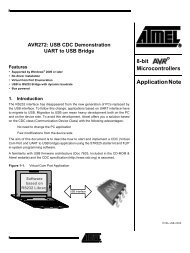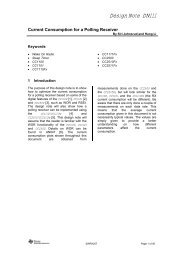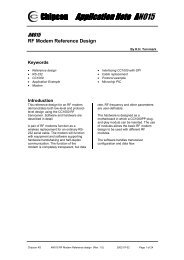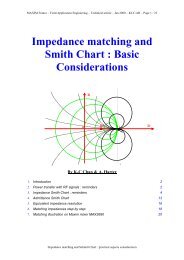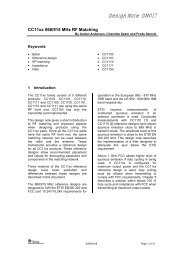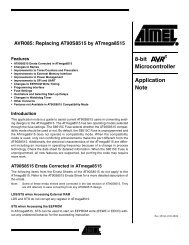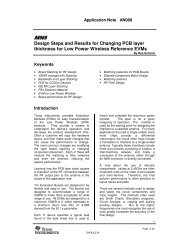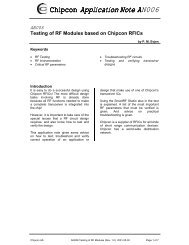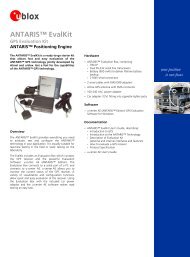Atmel QTouch Library User Guide
Atmel QTouch Library User Guide
Atmel QTouch Library User Guide
Create successful ePaper yourself
Turn your PDF publications into a flip-book with our unique Google optimized e-Paper software.
Maximum ON DurationIf an object unintentionally contacts a sensor resulting in a touch detection for a prolonged intervalit is usually desirable to recalibrate the sensor in order to restore its function, perhaps after a timedelay of some seconds.The Maximum on Duration timer monitors such detections; if detection exceeds the timer’ssettings, the sensor is automatically recalibrated. After a recalibration has taken place, theaffected sensor once again functions normally even if it still in contact with the foreign object.Max on duration can be disabled by setting it to zero (infinite timeout) in which case the channelnever recalibrates during a continuous detection (but the host could still command it).Setting Variable name Data Type Unit Min Max TypicalMaximum ON Duration qt_max_on_duration uint8_t 200 ms 0 255 30 (6s)Positive / Negative DriftDrift in a general sense means adjusting reference level (of a sensor) to allow compensation fortemperature (or other factor) effect on physical sensor characteristics. Decreasing reference levelfor such compensation is called Negative drift & increasing reference level is called Positive drift.Specifically, the drift compensation should be set to compensate faster for increasing signals thanfor decreasing signals.Signals can drift because of changes in physical sensor characteristics over time andtemperature. It is crucial that such drift be compensated for; otherwise false detections andsensitivity shifts can occur.Drift compensation occurs only while there is no detection in effect. Once a finger is sensed, thedrift compensation mechanism ceases since the signal is legitimately detecting an object. Driftcompensation works only when the signal in question has not crossed the ‘Detect threshold’ level.The drift compensation mechanism can be asymmetric; it can be made to occur in one directionfaster than it does in the other simply by changing the appropriate setup parameters.Signal values of a sensor tend to decrease when an object (touch) is approaching it or acharacteristic change of sensor over time and temperature. Decreasing signals should not becompensated for quickly, as an approaching finger could be compensated for partially or entirelybefore even touching the channel (negative drift).However, an object over the channel which does not cause detection, and for which the sensorhas already made full allowance (over some period of time), could suddenly be removed leavingthe sensor with an artificially suppressed reference level and thus become insensitive to touch. Inthe latter case, the sensor should compensate for the object’s removal by raising the referencelevel relatively quickly (positive drift).Setting Variable name Data Type Unit Min Max TypicalNegative Drift qt_neg_drift_rate uint8_t 200 ms 1 127 20 (4s)Positive Drift qt_pos_drift_rate uint8_t 200 ms 1 127 5 (1s)Positive Recalibration Delay188207K-AT42-09/11




